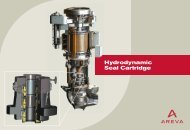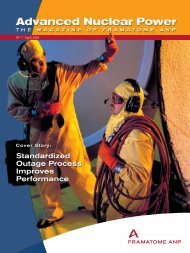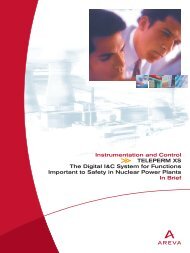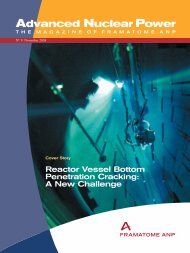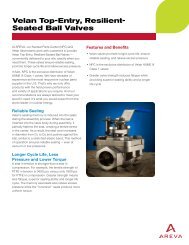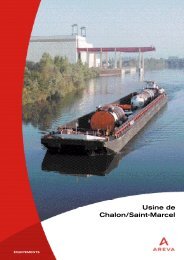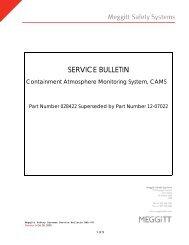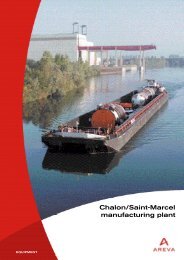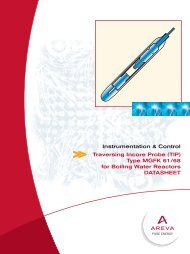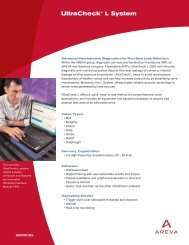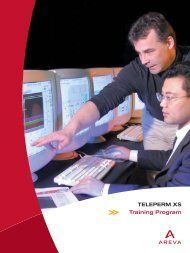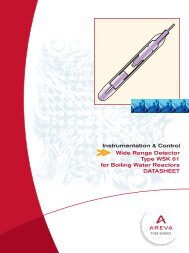EPR – Areva brochure
EPR – Areva brochure
EPR – Areva brochure
Create successful ePaper yourself
Turn your PDF publications into a flip-book with our unique Google optimized e-Paper software.
■ SAFETYDEFENSE IN DEPTHThe concept of “defense in depth” involves ensuring the resistanceof the protective barriers by identifying the threats to their integrityand by providing successive lines of defense which will guaranteehigh effectiveness:• first level: safe design, quality workmanship, diligent operation,with incorporation of the lessons of experience feedback in orderto prevent occurrence of failures,• second level: means of surveillance for detecting any anomalyleading to departure from normal service conditions in order toanticipate failures or to detect them as soon as they occur,• third level: means of action for mitigating the consequences offailures and prevent core melt down; this level includes use ofredundant systems to automatically bring the reactor to safeshutdown; the most important of these systems is the automaticshutdown by insertion of the control rods into the core, which stopsthe nuclear reaction in a few seconds; in addition, a set ofsafeguard systems, also redundant, are implemented to ensure thecontainment of the radioactive products,The training for steamgenerator inspectionillustrates:† the first level ofdefense in depthrelating to the qualityof workmanship,† the second barrier,as the training relatesto steam generatortubes which form partof the primary system.Lynchburg technical center (Va, USA): training for steam generator inspection.• beyond, the defense in depth approach goes further, as far aspostulating the failure of all these three levels, resulting in a “severeaccident” situation, in order to provide all the means of minimizingthe consequences of such a situation.† By virtue of this defense in depth concept,the functions of core power and coolingcontrol are protected by double or triplesystems <strong>–</strong> and even quadruple ones as inthe <strong>EPR</strong> <strong>–</strong> which are diversified to preventa single failure cause from concurrentlyaffecting several of the systems providingthe same function.† In addition, the components and linesof these systems are designed toautomatically go to safe positionin case of failure or loss of electricalor fluid power supply.<strong>EPR</strong> SAFETYThe first important choice, in line with the recommendations of the French and German Safety Authorities,was to build the <strong>EPR</strong> design upon an evolutionary approach based on the experience feedback from the96 reactors previously built by Framatome or Siemens. This choice enables the AREVA Group to offeran evolutionary reactor based on the latest constructions (N4 reactors in France and KONVOI in Germany)and to avoid the risk arising from the adoption of unproven technologies.This does not mean that innovative solutions, backed by the results of large-scale research anddevelopment programs, have been left out; indeed, they contribute to the accomplishment of the <strong>EPR</strong>progress objectives, especially in terms of safety and in particular regarding the prevention and mitigationof hypothetical severe accidents.These progress objectives, motivated by the continuous search fora higher safety level, involve reinforced application of the defense indepth concept:•by improving the preventive measures in order to further reducethe probability of core melt,• by simultaneously incorporating, right from the design stage,measures for limiting the consequences of a severe accident.† A two-fold safety approach againstsevere accidents:• further reduce their probability byreinforced preventive measures,•drastically limit their potentialconsequences.DESIGN CHOICES FOR REDUCINGTHE PROBABILITY OF ACCIDENTS LIABLETO CAUSE CORE MELTIn order to further reduce the probability of core melt, which is alreadyextremely low for the reactors in the current nuclear power plant fleet,the advances made possible with the <strong>EPR</strong> focus on three areas:The <strong>EPR</strong> complies with the safetyobjectives set up jointly by the Frenchand German safety authorities for futurePWR power plants:† further reduction of core melt probability,† practical elimination of accidentsituations which could lead to largeearly release of radioactive materials,† need for only very limited protectivemeasures in area and time*, in caseof a postulated low pressure core meltsituation.* No permanent relocation, no need for emergency evacuation outside theimmediate vicinity of the plant, limited sheltering, no long-term restriction inthe consumption of food.• extension of the range of operating conditions taken into accountright from design,• the choices regarding equipment and systems, in order to reduce therisk of seeing an abnormal situation deteriorate into an accident,• the advance in reliability of operator action.Extension of the range of operating conditionstaken into account right from designProvision for the shutdown states in the dimensioningof the protection and safeguard systemsThe probabilistic safety assessments highlighted the importance thatshould be given to the reactor shutdown states. For the <strong>EPR</strong>, theseshutdown states were systematically taken into account, both forthe risk analyses and for the dimensioning of the protection andsafeguard systems.The use of the probabilistic safety assessmentsAlthough the <strong>EPR</strong> safety approach is mainly based on the defense indepth concept (which is part of a deterministic approach), it is reinforcedby probabilistic analyses. These make it possible to identify the accidentsequences liable to cause core melt or to generate large radioactivereleases, to evaluate their probability and to ascertain their potentialcauses so that they can be remedied. In their large scale right from thedesign phase, the probabilistic assessments conducted for the <strong>EPR</strong>constitute a world first. They have been a decisive factor in the technicalchoices intended to further strengthen the safety level of the <strong>EPR</strong>.With the <strong>EPR</strong>, the probability of an accident leading to core melt,already extremely small with the previous-generation reactors,becomes infinitesimal:• smaller than 1/100,000 (10 <strong>–</strong>5 ) per reactor/year, for all types offailure and hazard, which fully meets the objective set for the newnuclear power plants by the International Nuclear Safety AdvisoryGroup (INSAG) with the International Atomic Energy Agency (IAEA)<strong>–</strong> INSAG 3 report,• smaller than 1/1,000,000 (10 <strong>–</strong>6 ) per reactor/year for the eventsgenerated inside the plant, making a reduction by a factor 10compared with the most modern reactors currently in operation,• smaller than 1/10,000,000 (10 <strong>–</strong>7 ) per reactor/year for the sequencesassociated with early loss of the radioactive containment function.46 II 47



